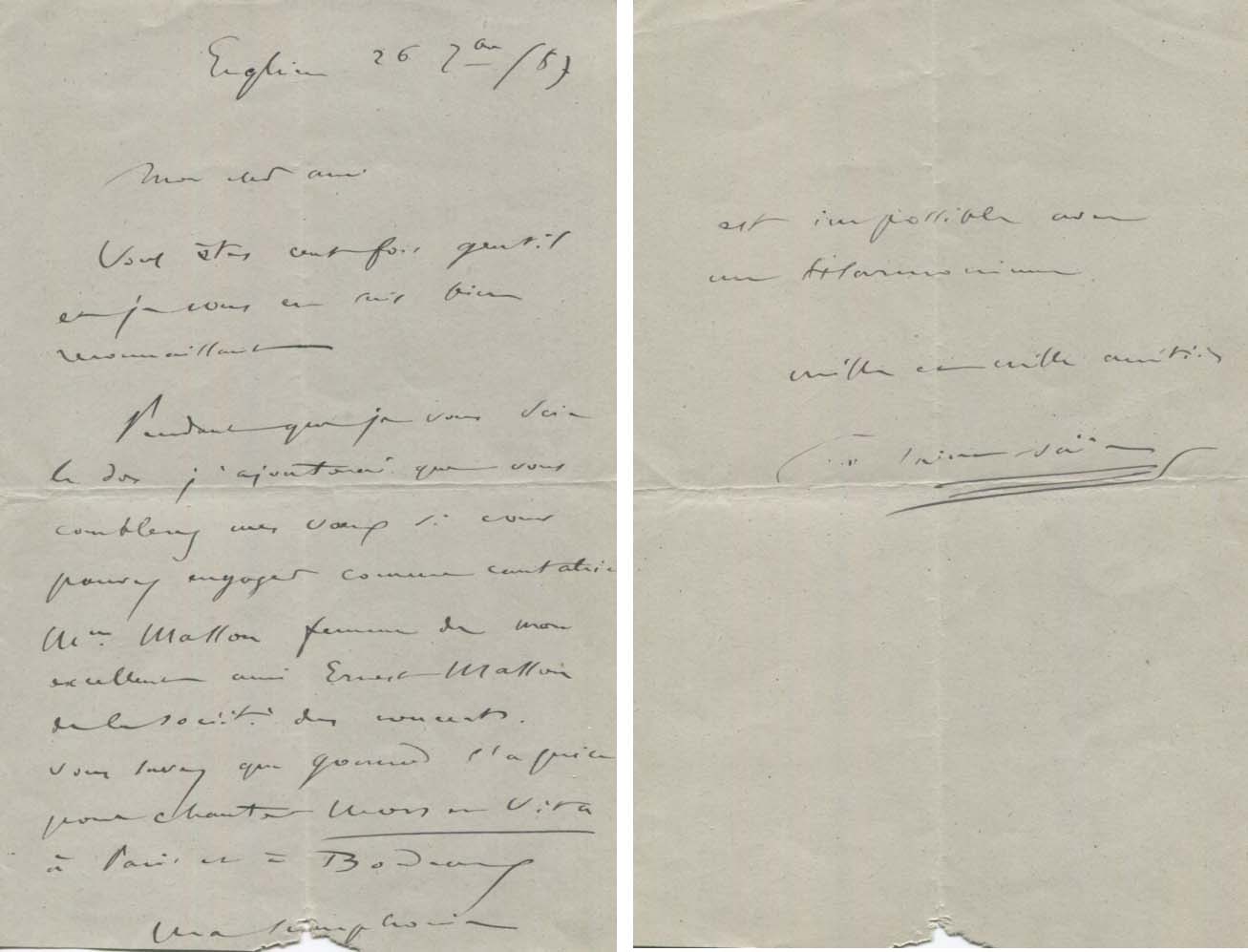Beschreibung
In Ausschnitten:
"[...] vous comblerez mes vœux si vous pouvez engager comme cantatrice Mme Masson femme de mon excellent ami Ernest Masson de la Société des Concerts. Vous savez que Gounod l`a prise pour chanter Mors et Vita à Paris [...]"
Übersetzt:
"[...] Sie werden meine Wünsche erfüllen, wenn Sie Frau Masson als Sängerin engagieren können, Ehefrau meines ausgezeichneten Freundes Ernest Masson von der Société des Concerts. Sie wissen, dass Gounod sie nahm, um `Mors et Vita`* in Paris zu singen. [...]"
* `Mors et vita` ist ein dreiteiliges Oratorium von Charles Gounod, das 1885 beim Birmingham Festival uraufgeführt wurde. Es war als Fortsetzung von `La rédemption` (1882) konzipiert. Bei der Pariser Premiere 1886 war erneut Jean-Baptiste Faure zu sehen. Gounod betrachtete dieses Oratorium und seinen Vorgänger `La Rédemption` (1882) als seine größten Errungenschaften.
Weitere Infos zur Person
Profession:
(1835 - 1921) Französischer spätromantischer Komponist, Organist, Dirigent und Pianist
Year of Birth: 1835
Camille Saint-Saens was born in Paris on October 9th, 1835 and was a French composer, organist, conductor and pianist. He was considered one of the great musical figures of the Romantic era and was known for incorporating a wide range of musical styles into his compositions.
He began studying piano at the age of three and was quickly recognized as a child prodigy. By the age of ten, he had composed two operas and at eleven he was admitted to the Paris Conservatoire, where he studied organ and composition. He also studied under notable figures such as Franz Liszt and Charles-Valentin Alkan.
He was able to compose in a variety of genres, from operas to symphonies to chamber music. His first opera, Le Timbre d’argent, was premiered in 1877. His most famous works include the opera Samson et Dalila, the Symphony No. 3 (Organ Symphony), and the Piano Concerto No. 2. He also wrote a number of works for solo piano, including the popular The Carnival of the Animals.
In addition to composing, Saint-Saens was also an educator and a conductor. He was appointed professor of composition at the Paris Conservatoire in 1871 and was the principal conductor of the Societe Nationale de Musique from 1871 to 1878. He also conducted throughout Europe, including in London, Berlin and Vienna.
Saint-Saens was a prolific composer who wrote more than 300 works. He is remembered for his mastery of both classical and modern styles of music, as well as for his incorporation of elements from folk music and jazz into his compositions. He was also well-known for his witty and often self-deprecating remarks.
Saint-Saens died in Algiers on December 16th, 1921, at the age of 86. He is remembered today as one of the great composers of the Romantic era and his influence can be seen in the works of many modern composers.
Echtheitszertifikat
Zahlung & Sicherheit
Deine Zahlungsinformationen werden sicher verarbeitet. Wir speichern keine Kreditkartendaten und haben auch keinen Zugang zu deinen Kreditkartendaten.



